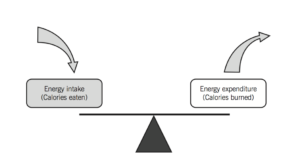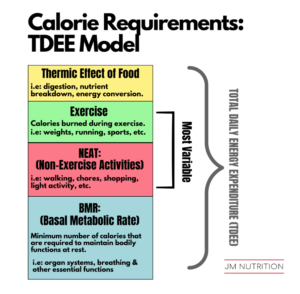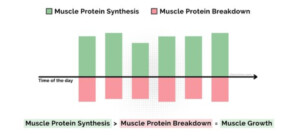
Data-Driven Nutrition Plan: The Ins and Outs
By: Austin McNally, RD, CSCS, CPT, BSc., Sports Nutrition Dietitian, Certified Strength and Conditioning Specialist, and Certified Personal Trainer, Edited by the JM Nutrition Team
Data-driven nutrition and accompanying plans are a hotly debated topic in certain nutrition and fitness circles. Before we examine the ins and outs of a data-driven nutrition plan, it is important to include a caveat.
Disclaimer
While all content has been approved by a registered dietitian and strives to provide only accurate, scientific-based information, your specific health needs may or may not apply to the content contained in this post. Data-driven nutrition, data tracking, diet monitoring, and so on, is not advisable for everyone. For those with a history of disordered eating habits, or personality-type predispositions for obsessive behaviours, and so on, data-driven nutrition plans are not advisable. Similarly, a data-driven nutrition plan is also not a requirement for success. Reason being, success largely depends on the ambitiousness of goals, baseline habits, current intake and other factors.
For example, an athlete who already has 12% BF, but would like to drop a weight class for competitive reasons requires a diligent, structured approach. A sedentary, overweight individual who would like to lose 10-15 pounds (4-7kg) for health-related reasons may not. This is a very important distinction. As always, we advocate a personalized approach to nutritional care and support.
That said, objective metrics can be extremely informative and helpful. In particular, those who like to see and follow the numbers may find that data-driven nutrition plans work well for them.
Let’s now analyze the ins and outs of a data-driven nutrition plan.
Energy Balance
Before diving into the more nuanced components of an effective diet, we must first address the most fundamental concept: energy balance.
Let’s begin with a close look at calories.
The calorie is a unit of energy. We most commonly use the measure of calories to quantify our energy intake. That is, calories consumed through food. Day-in and day-out we consume calorie-containing foods. Our body uses these to carry out metabolic functions and propels us through the day. The sum of our daily caloric intake is often referred to as ‘energy intake’. This is because calories = energy. It represents half of the energy balance equation.
As previously alluded to, our body runs on calories. We depend on our caloric intake to sustain metabolic processes, activities of daily living and to get us through our most rigorous exercise sessions.

Infographic courtesy of Precision Nutrition
Again, calories are simply the measure of energy. This energy can be harvested and metabolized from physical substrates (carbohydrates, for example) to produce ATP, and drive physiological processes.
There are many components of energy expenditure: Basal Metabolic Rate, Physical Activity, Non-Exercise Activity Thermogenesis and the Thermic Effect of Food. Each of these components contributes disproportionately to our Total Daily Energy Expenditure (TDEE). This is a useful approximation of how many calories we burn in a day. It is significantly more challenging to quantify our energy expenditure as most of us don’t live our lives in a metabolic chamber.
TDEE Model

At its most simplistic, energy balance refers to the differential between total energy consumed, and total energy burned. In other words, if you consume more calories than you expend (calorie surplus), you could gain weight over time. Meanwhile, if you consume fewer calories than you expend (calorie deficit), you could lose weight over time.
Although there are many factors (hormones, age, food environment, genetic predispositions, etc.) that impact and influence our ability to effectively create and sustain our desired energy balance, the underlying concept, according to Journal of the International Society of Sports Nutrition, is rooted in thermodynamics. And, nobody escapes physics! That much is clear. I’m sure you’ll agree.
Dynamic Process
The dynamic nature of energy balance throws a wrench in the works. This is especially true as our body composition changes over time. By altering the total amount of metabolic tissue we carry, we effectively change the proportions of calories we require and burn throughout the day.
It is less ‘demanding’ to carry around 160 pounds (~73kg) versus 180 pounds (~82kg). This effectively changes the number of calories we require to sustain basic function and activities of daily living throughout the day.
To further complicate the situation, our metabolism expresses these dynamic adaptations in our energy expenditure by adjusting our metabolic rate. This is most commonly observed during weight loss (sustained calorie deficits). It is here that our body attempts to mitigate the negative energy balance by reducing our day-to-day expenditure through compensatory reductions in TDEE.
This is why we inevitably encounter plateaus during sustained diets. What works in the beginning is unlikely to continue to work indefinitely. This is the reason why we need to have a progression protocol in place to continue to see progress as we continue with our weight management efforts. But more on this later.
From an evolutionary standpoint, this process was an important survival mechanism that was useful in preventing starvation during bouts of food scarcity. Nowadays, it is more often perceived as an annoyance, and an undesirable effect of ‘dieting’.
Calorie Configuration
Now that we have a broad understanding of energy balance, we can look at configuring specific calorie targets to more meaningfully influence our progress over time. The best place to start is by calculating your TDEE. Again, TDEE stands for Total Daily Energy Expenditure.
Now, unless you have a previous log of food intake and bodyweight overtime, we will need to use a TDEE calculator to provide us with a baseline estimate of our calorie requirements. Simply search TDEE calculator on Google. Next, plug in your biometrics. The calculator will spit out an estimate of your total daily energy expenditure. This can then be adjusted based on your specific goal.
To further contextualize this concept, consider the following scenario.
Scenario: Goal: Weight loss
Your estimated TDEE is approximately 2,900 calories. This is the number of calories you’d theoretically require everyday to maintain your current body weight.
Based on our understanding of energy balance, we know we must sustain a calorie deficit to successfully lose weight over time. A 10-20% reduction in energy intake (below TDEE) is a reasonable, conservative approach for most people.
By applying basic mathematical principles, we can estimate a daily calorie target that would facilitate weight loss overtime.
2,900 x 0.8 (representative of a 20% reduction in calorie intake)
= 2,320 calories per day.
2,900 – 2,320
= 580 calories (representative of a daily deficit of 580 kcal)
Related: Weight loss counselling with nutritionist
Why Work with a Weight Loss Coach
For the sake of clarification:
In this scenario, aiming for a daily calorie intake of 2,320 per day constitutes a daily deficit of 580 kcal. This is a 20% reduction in energy intake compared to our weight maintenance requirement of 2,900–as determined by our TDEE estimate. Consistently consuming 2,320 calories per day would lead to weight loss at a rate of approximately ~1 pound (0.45kg)/week.
Now that we’ve established our calorie target, we need to translate this information into an objective, practical system that will help us determine whether we are actually hitting our calorie targets. The old saying “you don’t know what you don’t know” is analogous with the situation at hand. How can we know that we are hitting our caloric objectives if we don’t have a system in place to quantify our intake?
Well, we have three options. One, we can adopt an intuitive approach. Two, estimate our intake. Three, track our food consumption.
Let’s examine each approach.
Intuitive
The intuitive approach is less time consuming. It is also far less tedious than the other methods. That said, it is the least accurate. This method is an intuitive approach whereby we do our best to ‘clean-up’ our diet. We also work on becoming more mindful and intentional with our food choices.
Beyond that, we don’t collect, or rely on objective data to show us that we are indeed creating a calorie deficit, or calorie surplus (depending on goal).
In other words, this method requires us to assume that the changes we make in our day-to-day intake results in the gap we hope to create regarding energy balance.
Estimate
Using the estimate method, we keep a food log, or record of intake in an effort to estimate our total calorie consumption. This method requires approximations of portions. It also necessitates a higher degree of food and calorie awareness. Although the estimate method is more tedious, it is more informative than the intuitive method.
Track and measure
The track and measure method is by far the most burdensome, tedious method of quantification. To use this method effectively requires the use of a digital food scale to weigh portions. This may not be possible for some.
In addition, it calls for some sort of logging system. This could be a downloadable app, or excel spreadsheet to track intake overtime. The choice is yours.
Even within this category, there are varying degrees of accuracy that can be exercised depending on your desired level of precision and the ambitiousness of your goals.
For example, a true approximation of your actual intake would require condiments, nibbles, bites, handfuls, sips, and so on, to be measured and logged. Reason being, these are all sources of calories. Even then, there is room for error. This is because we effectively rely on the accuracy of our input data.
Furthermore, it should be noted that the level of precision and accuracy necessitated for success is very different from person to person, and is highly dependent on the individual’s starting point.
For example, let’s take a college wrestler that has 12% body fat, who would like to drop a weight class for competitive reasons. This athlete will no doubt require a high level of detail and precision in their approach. This detail and precision will have to be much higher, when compared to a middle-aged person who would simply like to lose a few pounds for health and longevity reasons.
In other words, you can achieve good results with any method (or a combination thereof), when you are diligent and consistent overtime.
Macro Breakdown
There are many other important dietary considerations beyond caloric intake when it comes to structuring a well-balanced, effective diet or data-driven nutrition plan.
Of course, it’s essential to choose nutritious foods with a robust micronutrient profile. This is true not only in the context of weight management, but overall health as well.
Moreover, the proportions of macronutrients, namely protein, fat and carbohydrates that make-up our day to day intake are important. They can impact goal-achievement depending on the outcomes we hope to realize.
Protein
As most of you probably know, protein is a particularly important macronutrient.
Why?
It facilitates muscle recovery, maintenance and hypertrophy. This is especially true in persons who regularly participate in muscle damaging activities such as weight-training.
Protein contains approximately four calories per gram. Despite this fact, it is considered to be more satiating than other macronutrients even in iso-energetic amounts.
According to the 2017 JISSN position stand, a protein intake of 1.4-2.0g/kg appears to be sufficient for most exercising individuals, but depending on the exercise type (i.e. weight-training) and desired outcome (i.e. muscle growth), a protein intake upwards of 1.6-2.2g/kg may be advisable.
Pertaining specifically to muscle hypertrophy, protein intake is important as it elicits MPS. MPS stands for muscle protein synthesis. It simultaneously inhibits muscle protein degradation. Just as energy balance is dynamic, so is the process of muscle hypertrophy, as our body is constantly balancing muscle protein synthesis and muscle protein breakdown. It is the net result of daily MPS vs. MPB that drives muscle growth overtime (see chart below).
Related: Making sense of muscle protein synthesis. International Journal of Sport Nutrition and Exercise Metabolism
If you disperse your daily protein intake into a minimum of three protein-containing meals, it may further benefit your muscle hypertrophy efforts as you are able to elicit a MPS response more often. This can maximize muscle gain by minimizing muscle protein degradation.

Fat
Fat is a macronutrient. It’s the most calorie dense macronutrient. It contains approximately nine calories per gram. Just as protein plays a conditionally essential role in health and wellbeing, fat is a critical dietary component that is pivotal in many bodily functions. According to heart.org fat is crucial to support cell function, facilitate fat-soluble vitamin absorption and contribute to hormone production.
What’s more, there are many subclassifications of dietary fat. It’s also important to note is that not all sources are equally nourishing.
Mono and poly-unsaturated fats
Mono and poly-unsaturated (Omega 3 and 6) fats can help to improve blood cholesterol levels by increasing HDL (H for Healthy) cholesterol. Due to its favourable impact on blood cholesterol, if you consume an omega-rich diet, you can help to reduce risk of heart disease.
Related: Cardiovascular dietitian
Dietitian for high cholesterol
Saturated fats
Saturated fats are found in highly processed foods, animal-based products and, to a lesser extent, some plant-based foods. Excessive saturated fat intake is known to negatively impact blood cholesterol levels and contribute to an increased risk of cardiovascular disease. A high saturated fat intake can raise LDL (L for Lousy) and apolipoprotein B, a fat carrying protein molecule that is particularly atherogenic. For this reason, it is advisable to seek out unsaturated fat sources more often.
Trans fats
Trans fat is an artificial, commercially manufactured fat. It has been added to many foods in order to increase their shelf-life, enhance taste and improve texture. Trans fat is known to increase LDL cholesterol and decrease HDL cholesterol. However, as of September 2018, the addition of trans fat to food products in Canada has been banned.
Dietary fat should make up approximately 25-35% of your total calorie intake. Reasons being, to reap health benefits, optimize metabolic health and avoid deleterious effects that may be associated with inadequate fat intake.
Carbs
Carbohydrates are the last macronutrient we need to consider in a well-rounded diet.
Similarly to protein, a singular gram of carbohydrate contains approximately four calories. In recent years, carbohydrates have undergone a fair amount of stigmatization in the media. For this reason many folks attempt to minimize carbs. Others even completely avoid carbohydrates in their diet.
Unlike protein and fat, carbohydrate is not considered to be conditionally essential for survival. For context, a diet completely void of protein or fat would lead to many negative health repercussions. Conversely, a non-carbohydrate diet is survivable.
Nonetheless, carbohydrate is an extremely valuable macronutrient that serves as an excellent source of nutrients and energy. Carbohydrates are an especially important macronutrient for athletes and exercising individuals who wish to optimize their performance. In fact, during moderate to high intensity exercise, our body relies nearly exclusively on carbohydrates for fuel and energy. This is a very important consideration for performance optimization. Athletes, pay heed.
More from International Society of Sport Nutrition: Position Stand–Nutrient Timing
To set a practical a daily carbohydrate intake goal, you should first figure out the amount of protein and fat you require. You then fill-in your leftover calories with carbohydrates. In other words, your daily carbohydrate target will vary considerably depending on your total energy goal. Reason being, fat and protein requirements are relatively fixed in order to maintain bodily functions and optimize metabolic processes. Carbohydrate intake, on the other hand, is more flexible.
Let’s illustrate the point.
Example:
On a 2,500 calorie diet, your body necessitates a certain amount of dietary fat and protein. Total carbohydrate intake, on the other hand, is inconsequential in comparison.
However, for athletes or those most interested in increasing exercise performance, it is advisable to follow a higher carbohydrate containing diet. Depending on sport type, duration and intensity, a carbohydrate intake of 5-8g/kg is generally sufficient. However, endurance-based athletes may require up to 12g/kg to maximize glycogen reserves and carbohydrate availability during exercise.
More from International Society of Sport Nutrition: Position Stand–Nutrient Timing.
Weight Trend Monitoring
First, it’s important to point out that the number reflected on the scale is simply an objective data point. It is certainly not tell-tale of progress markers such as improvements in diet quality, day-to-day energy energy, GI functioning, body composition, etc.
That said, however, it is the most readily observable data point that can be useful for providing insight into weight-loss or weight-gain overtime when measured consistently.
Granted, our body weight undergoes pretty drastic daily fluctuations that are primarily driven by sodium, fluid and glycogen retention. It’s also important to remember that these day to day fluctuations are completely normal. We shouldn’t let them sway us off course. A much better indicator of true weight change overtime is to observe weight trends over time, or using a running average.
If we monitor dietary intake and observe its effect on body weight, we can make fairly accurate inferences as to whether our energy consumption is excessive, inadequate or just right.
Furthermore, it allows us to titrate our energy intake based on the relative changes we observe in our body-weight overtime. To observe these data trends is extremely useful because it helps make informed decisions regarding our progression system, and when we may need to make alterations to our dietary intake based on our goals.
Progression System
Now that we have a more comprehensive understanding of the dynamic process of energy balance, we can dive a bit deeper into the importance of having a progression system in place.
A progression protocol is particularly important in the context of weight loss due to the physiological adaptations that occur in response to reductions in body weight. As previously mentioned, plateaus are an inevitability.
We can, however, navigate them with a greater degree of success, when we have a plan in place. After all, he who fails to plan is planning to fail. This is an adage that’s quite relevant here. The informative data collected through dietary and weight trend monitoring will allow us to determine when we have encountered a plateau.
In a scenario where we attempt to gain body mass, the cessation of weight gain associated with the consumption of a given number of calories would tell us that in order to continue to gain mass, we’d need to increase our caloric intake to account for compensatory mechanisms and adaptations that our body has made.
Conversely, a cessation of weight loss would indicate that it is time to make further adjustments to our daily intake to account for the adaptations our body has made in response to the reductions in weight.
Conclusion
We hope that we were able to shed some considerable light on the ins and outs of a data-driven nutrition plan. As always, if you have any feedback, please feel free to let us know. If you’re interested in working with our sports nutrition experts and/or require assistance with the creation of a personalized data-driven nutrition plan, book a free consultation. During the consultation we can outline how the process works. We can also answer any questions or concerns you may have.
We also encourage you to take a look at the following pages for more information.
Nutritional Support For Endurance Athletes
Working with an online nutritionist
Other Popular Posts:
How to Gain Muscle and Lose Fat
Strength Training Diet Myths and Misconceptions
Pre-Training Nutrition for Sports and Fitness
Factors That Influence Food Choices
Endurance Athletes Nutrition Misconceptions
What Workout Supplements Should I Take?
JM Nutrition’s blog was named one of the Top 100 Nutrition Blogs, Websites and Newsletters to Follow in 2022 and one of the Top Canadian Nutrition Blogs by Feedspot. So don’t miss out and subscribe below to both the newsletter that includes latest blog posts.
JM Nutrition is a nutrition service by dietitians in Canada. Main area of service: dietitians in Ontario. Main office: nutritional counselling Toronto
Also visit: nutritionist in Ottawa, nutritionist Halifax, nutritionist services Vancouver, nutritionist Edmonton, nutritionists Calgary, dietitian Saskatoon, dietitian Regina, dietitian in Winnipeg and more.


